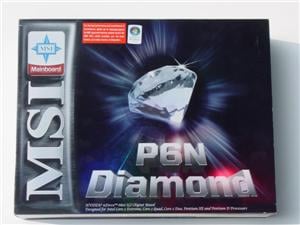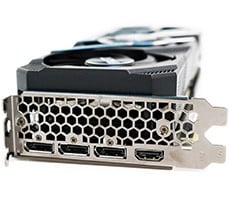
Not too far back, there was a time when it was inconceivable that a motherboard had anything other than a green or mustard colored PCB that had a few sockets for the CPU and DIMMs, maybe a hard drive connector or two, and a floppy drive connection. Keyboards and mice were typically PS/2 based, although a COM port sufficed for those still attached to their serial mice, and the list of input/output options were quite few. The late 90's brought about the rise of the Universal Serial Bus, a new standard for interfacing with devices intended to retire legacy serial and parallel ports (although that still has yet to fully come about). Integrated LAN options as well as limited IGPs also began to expand the options of a motherboard, essentially making motherboards almost completely integrated, while taking sales away from third-party AIB vendors.
One final piece of the puzzle came about by adding audio to the mainboard, most often by the way of an audio CODEC chip. Up until now, a few companies had tried their hand at producing audio cards with mixed success. The king of add-in audio solutions, Creative Labs, held court by either outperforming or simply outpurchasing the competition, until they were left as the de-facto standard. The onrush of integrated components, however, lowered the demand for many of Creative's higher-end (and higher priced) audio cards. It's estimated that the retail sales of their discrete audio cards only accounted for 10% of their total sales number for 2006. Logically, to stay competitive and keep the Sound Blaster legacy alive, there was really only one direction to turn to; to get "creative" in the motherboard field as well.
On-board solutions from Creative Technology, as they are now known, are not necessarily new. Onboard versions of their Live! chipset have been around mostly on OEM boards for years, and the 24-bit Sound Blaster Live! has been promoted on some of the upper level boards in the last couple of years as a suitable replacement for gamers with support for 24 bit, 96 kHz surround audio and EAX Advanced HD. MSI was one of the first manufacturers to adopt it in the K8N SLI Platinum and it is MSI that again pushes the envelope by including an integrated solution based on the Creative X-Fi audio processor.

MSI P6N Diamond



 |
| MSI P6N Diamond Specifications |
| L | |
|
CPU Support
- Supports Socket 775 for Intel Core 2 Quad, Core2 Extreme, Core2 Duo, Pentium 4 (Prescott, P4EE), Pentium D, Pentium XE/Celeron D processors in LGA 775 package
- Supports Intel 05B/05A and 04B/04A processors
- Supports EIST techonology
- Supports Intel Hyper-Threading (HT) Technology
- Supports Intel Dual Core Technology to 1333MHz and up
Chipset
NVIDIA nForce 680i SLI (C55)
- Supports FSB 800MHz, 1066MHz, & 1333MHz* (FSB 1333 requires FSB 1333 CPU and manual adjustment in BIOS)
- Support Dual channel DDR2 533/667/800 memory interface up to 8GB
- Supports Dual PCI Express 16x interface with either 1x16 + 1x8 or 2x8 operation
NVIDIA nForce 590i (MCP55XE)
- Integrated Hi-Speed USB 2.0 controller, 480Mb/sec, 10 ports
- 5 Serial ATAII ports w/ transfer rate up to 3Gb/s and support RAID 0, 1, 0+1, and 5
- 1 channel Ultra ATA 133 bus Master IDE controller for up to two IDE drives
- PCI Master v2.3, I/O ACPI 2.0 Compliant
Front Side Bus
- 1333/1066/800 MHz supported
Memory
- Supports dual channel DDR2 533/667/800 and up, using four 240-pin DDR2 DIMMs
- Supports up to 8GB memory size
- Supports 1.8v DDR2 SDRAM DIMM
Expansion Slots
- Four PCI Express X16 slots (supports PCI Express Bus specification v1.0a compliant)
- Four PCI Express interface operates at either X8+X8+X16+X8 or 16X+16X+8x modes
- One PCI Express X1 slot
- Two PCI 2.3 32-bit Master PCI Bus slots(support 3.3v/5v PCI bus interface)
Audio
Creative Sound Blaster X-Fi Xtreme HD Audio
- 24-bit / 96 kHz playback and recording
- Up to 100db signal to noise ratio
- X-Fi Crystalizer, CMSS-3D Virtual, CMSS-3D Headphone technology
- Up to 7.1 channel surround sound, Dolby Digital ready
Storage
On-board IDE / SATA
- Single IDE controllers on the nForce 430i chipset provides IDE HDD/CD-ROM with PIO, Bus Master, or UDMA 133/100/66
- Can connect up to 2 IDE drives
- nForce 590i supports 5 SATA II ports (SATA1-5). Transfer rate is up to 300 MB/s
- NV RAID supports RAID 0, 1, 0+1, 5 JBOD
SiliconImage Sil4723 Hardware RAID
- SATA 6-7 support RAID 0 or RAID 1 modes
External eSATA
- One SATAII port by Sil3531 (on back panel)
LAN
Realtek RTL8211B PCI-Express Gb LAN Controller
- Supports 10/100/1000 Mb/s.
IEEE 1394
VIA 6308P chipset
- Supports up to two 1394 ports
- Transfer rate is up to 400Mbps
|
Back Panel I/O Ports
- 1 x PS/2 Mouse Port
- 1 x PS/2 Keyboard Port
- 1 x eSATA Port
- 1 x IEEE 1394 port
- 2 x LAN jacks
- 4 x USB 2.0/1.1 ports
- 5 x Audio ports
- 1 x Optical SPDIF Jack
- 1 x Coaxial SPDIF Jack
Internal I/O Connectors
- ATX 24-Pin power connector
- 8-pin ATX 12V power connector
- CPU / 3 x System FAN connectors
- 1 x CD-in connector
- Clear CMOS jumper
- Chassis intrusion switch connector
- IrDA infrared module header
- Serial port connector
- Front panel audio connector
- Front panel connector
- 3 x USB 2.0 connector support additional 6 ports
- 1 x Floppy disk drive connector
- 7 x Serial ATAII connectors
- 1 x ATA133 connector
- 1 x IEEE1394 connector support additional 1 port
- 1 x D-Bracket 2 pinheader
Accessories
- 6 x SATA cables
- 3 x SATA power cable
- 1 x IEEE 1394a bracket
- 1 x IDE cable (rounded)
- 1 x FDD cable (rounded)
- 1 x I/O Shield
- 1 x D-Bracket 2
- 1 x SLI Video link cable
- Driver/Utilities CD-ROM
- X-Fi Drivers CD-ROM
- User Guide
- Quick Installation Guide
Software
- Drivers
- MSI DigiCell
- MSI Dual Core Center
- MSI Live Update
Form Factor
- ATX Form Factor, 11.96"x 9.61" (30.5cm x 24.5cm)
Special Features
MSI DigiCell
- Extend mainboard network function
- Support onboard audio
- Support MEGA Stick MP3 player settings
MSI Dual Core Center
- Key components status hardware monitor
- Monitor the Dual Core CPU each unit status
- D.O.T. Technology up to 12% improvement
- Optimize System status define
- Auto speed up with system loading change
- 5 environment modes and 3 user defined modes
MSI Live Update
- End-users only have to connect to the download center to receive files automatically
MSI Dual Core Cell
- Integrates and optimizes multiple internal circuits
- Reduces the signal noise dramatically
- Delivers perfect and precise data transmission
- Automatically adjusts the fan speed to maintain the system cooling vs. noise level
|



The bundle included with the P6N Diamond was nearly identical to what we found with the P965 Platinum, and we can't complain as it covers almost everything we could think of. This includes six SATA data cables (two more than the P965), rounded IDE and floppy cables, three SATA power cables, and the I/O shield. Two brackets provided in the bundle allow for additional FireWire and USB connections, as well as a means of diagnosing issues with the motherboard via a LED readout. A Quick Installation Guide, User's manual, registration form and a collection of driver CDs round out the bundle. The user manual is mostly complete, covering everything from setting up the hardware to fine tuning the BIOS and audio.













